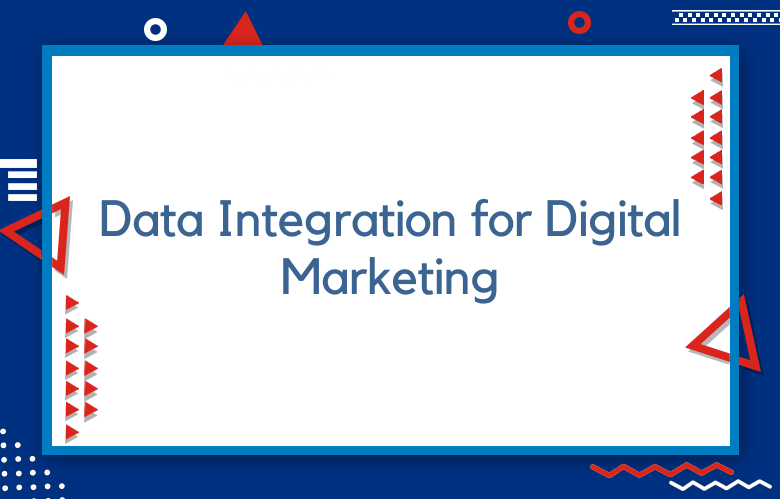Data Integration for Digital Marketing: Best Practices Unveiled

Data integration in digital marketing is the strategic process of consolidating data from diverse sources—such as social media, websites, CRM systems, and email platforms—into a cohesive, comprehensive view.
Data Integration for Digital Marketing: Best Practices Unveiled
This practice is crucial for digital marketers aiming to create a unified understanding of customer behaviors, preferences, and interactions across multiple touchpoints. Marketers can deliver more personalized, consistent, and impactful marketing campaigns by integrating data.
Best practices in data integration for digital marketing involve not only the technical aspects of data consolidation and management but also strategic considerations for how data is used to drive marketing decisions. Key components include ensuring data quality and consistency, maintaining privacy and security standards, and leveraging advanced analytics to extract actionable insights.
Effective data integration allows for a more holistic view of the customer journey, enabling marketers to identify critical touchpoints, optimize customer experiences, and improve campaign effectiveness. Additionally, it supports advanced analytics and AI-driven marketing strategies, providing the rich, unified data necessary for predictive modeling and personalization at scale.
Adopting best practices in data integration can significantly enhance the agility and effectiveness of digital marketing strategies, driving better customer engagement, higher conversion rates, and increased ROI. It requires a thoughtful approach to data architecture, governance, and analytics, underpinned by a commitment to data-driven decision-making and continuous improvement.
- Key Takeaways
- Understanding Data Integration Basics
- Importance of Data Integration in Marketing
- Critical Concepts in Data Integration
- Tools and Techniques for Effective Integration
- Types of Data Integration Methods
- Overcoming Challenges in Data Integration
- Best Practices for Data Integration Success
- Real-World Examples of Successful Integration
- Future Trends in Data Integration
- Closing Thoughts
- Frequently Asked Questions
- What is the significance of data integration in digital marketing?
- How can businesses overcome challenges in data integration for marketing purposes?
- What fundamental techniques and tools are used for effective data integration in marketing?
- Can you provide examples of successful real-world data integration practices in digital marketing?
- What are the future trends expected in data integration for digital marketing?
Successful campaigns hinge on effective data integration in the digital marketing world. The ability to seamlessly merge and leverage various data sources is a game-changer. Data integration for digital marketing allows businesses to optimize strategies, precisely target audiences, and drive impactful results. It’s the difference between scattered efforts and cohesive, targeted initiatives that yield tangible outcomes by breaking down data silos and achieving unified data through application integration. By harnessing the power of integrated data and application integration, marketers can unlock valuable insights, enhance customer experiences, and stay ahead of the competition.
Key Takeaways
Data integration is crucial for optimizing digital marketing efforts
Marketers can gain valuable insights by effectively merging data from various sources to enhance their strategies and improve campaign performance.
Utilize tools and techniques for seamless integration
Implementing tools like ETL (Extract, Transform, Load) processes and APIs can streamline data integration, ensuring accuracy and efficiency in marketing operations.
Address challenges proactively
To maintain a smooth process, be prepared to tackle common obstacles in data integration, such as data quality issues, compatibility issues, and security concerns.
Adopt best practices for successful data integration
Establish clear objectives, maintain data quality standards, and regularly monitor and evaluate the integration process to ensure its effectiveness.
Learn from real-world examples.
Explore successful cases of data integration in marketing to understand practical applications and potential outcomes that can inspire your strategies.
Stay informed about future trends.
Keep abreast of emerging technologies and trends in data integration to adapt and evolve your marketing practices for continued success in a rapidly changing digital landscape.
Understanding Data Integration Basics
Definition Role
Data integration is the process of combining data from different sources to provide a unified view. It plays a crucial role in digital marketing by enabling businesses to access and analyze diverse datasets.
Data integration ensures that information flows seamlessly across various platforms, allowing marketers to gain comprehensive insights into customer behavior and preferences. Companies can create a holistic view of their audience by merging data from sources like CRM systems, social media platforms, and website analytics tools.
Process Analysis
Data integration starts with data collection, where information is gathered from multiple sources, such as online interactions, transactions, and customer feedback. Next, this data undergoes transformation, cleaned, standardized, and organized for consistency.
After transformation, the integrated data is loaded into a centralized repository for analysis. This step involves mapping relationships between different datasets to ensure accurate insights. Finally, the integrated data is analyzed using advanced analytics tools to extract valuable information for decision-making.
Benefits Success
Understanding the basics of data integration is paramount for achieving success in digital marketing. By integrating data effectively, marketers can personalize their campaigns based on customer preferences, leading to higher engagement and conversion rates.
Moreover, data integration enables businesses to track the effectiveness of their marketing strategies in real time. Marketers can identify trends, optimize campaigns, and make data-driven decisions to enhance overall performance by analyzing integrated datasets.
- Improved targeting and segmentation
- Enhanced campaign performance tracking
- Better ROI measurement
Importance of Data Integration in Marketing
Enhanced Strategies
Integrated data shapes marketing strategies by providing a comprehensive view of various marketing efforts. Marketers can analyze marketing performance across different channels, enabling them to make data-driven decisions. This leads to more targeted and effective marketing strategies.
Data integration allows for the seamless flow of information, ensuring that all aspects of digital marketing are interconnected. Marketers gain valuable insights into customer interactions and behaviors by consolidating data from various sources. This enables them to tailor their marketing strategies using data integration tools to meet specific customer needs and preferences.
Improved Customer Experiences
One key benefit of data integration in digital marketing is enhancing customer experiences. By combining data from multiple touchpoints, marketers can create a unified view of each customer. This holistic view enables personalized communication through channels such as email marketing, resulting in more relevant and engaging interactions.
Marketers can anticipate customer needs through integrated data and deliver timely, targeted messages. This level of personalization not only improves customer satisfaction but also increases brand loyalty. By understanding customer behavior patterns, marketers can offer tailored solutions that resonate with their audience.
Proactive Strategy Development
Data integration is essential for developing proactive marketing strategies anticipating market trends and consumer demands. Marketers can identify patterns and correlations that inform future decision-making by analyzing integrated data sets. This proactive approach allows businesses to stay ahead of the curve and adapt their marketing strategy accordingly.
Integrated data empowers marketers to collaborate effectively with ad partners and other stakeholders. By sharing real-time insights derived from integrated datasets, marketers can optimize campaigns for better results. This collaborative effort ensures that all parties involved are aligned with the overall marketing strategy, leading to improved sales performance.
Critical Concepts in Data Integration
Automation Tools
Data integration for digital marketing heavily relies on automation tools and platforms to streamline the process. These tools enable seamless data flow between various systems, eliminating manual intervention.
Automated platforms like Zapier and Segment allow marketers to effortlessly integrate data from multiple sources, such as CRM systems, social media platforms, and email marketing tools. By automating these processes, marketers can save time and reduce the risk of errors in data integration.
Data Processing for Analysis
Data processing plays a crucial role in preparing integrated data for analysis in digital marketing. Before analysis can be conducted, raw data needs to be cleaned, transformed, and standardized to ensure accuracy and consistency.
Processing data involves tasks like deduplication, normalization, and enrichment to make it suitable for analysis. Through this process, marketers can derive valuable insights that drive informed decision-making and targeted marketing strategies.
Centralized Data Storage
In digital marketing, data warehousing is a centralized repository for storing integrated data. This centralized storage solution allows marketers to access a unified view of their data from various sources.
Tools and Techniques for Effective Integration
Data Integration Tools
Various tools are available to streamline data integration for digital marketing. These tools facilitate the seamless data flow between different systems, ensuring integration accuracy and efficiency. Examples include Zapier, Segment, and Informatica.
ETL and ELT Methods
Utilizing ETL (Extract, Transform, Load) and ELT (Extract, Load, Transform) methods in integration processes can significantly enhance data processing capabilities. ETL focuses on transforming data before loading it into the target system, while ELT loads raw data first and then converts it within the target system itself.
Importance of Data Governance
Data governance plays a crucial role in ensuring the effectiveness of integration projects. Organizations can maintain data quality, consistency, and security throughout the integration process by establishing clear rules, policies, and procedures for managing data assets.
Application integration strategies are essential for achieving a comprehensive view of data across various systems. By implementing automation tools and techniques, digital marketing teams can access real-time insights from multiple sources. This approach enables them to make informed decisions based on a holistic view of their data landscape.
One key benefit of ETL methods is extracting relevant information from diverse source systems and transforming it into actionable insights for marketing campaigns. This process streamlines data management tasks and provides marketing teams with a unified view of customer information.
On the other hand, ELT methods offer flexibility by allowing organizations to load raw data directly into the target system before performing transformations. This agile approach empowers teams to adapt quickly to changing business requirements and extract meaningful intelligence from their datasets.
Implementing robust data governance practices ensures organizations control their data assets throughout the integration project lifecycle. By defining roles and responsibilities within cross-functional teams, companies can effectively manage data quality issues and mitigate inaccurate or incomplete information risks.
Types of Data Integration Methods
ETL Vs. ELT
ETL (Extract, Transform, Load)
- ETL involves extracting data from multiple sources, transforming it into a consistent format, and loading it into a target system.
- This method suits businesses with complex data transformation requirements and structured data sources.
ELT (Extract, Load, Transform)
- ELT involves extracting data, loading it into the target system, and performing transformations within the target database.
- It is ideal for organizations that work with large datasets and unstructured data sources, such as social media feeds or IoT devices.
Suitability Based on Dataset Size and Complexity
Small Datasets & Structured Data
ETL proves efficient for small datasets with well-defined structures as it streamlines the transformation process before loading the data.
Large Datasets & Unstructured Data
In scenarios where large volumes of data need to be processed without predefined structures, ELT shines by leveraging the processing power of modern databases.
Advantages of Choosing the Right Data Integration Method
Enhanced Performance
Selecting the appropriate method enhances performance by optimizing data processing workflows tailored to specific business needs.
Improved Decision-Making
Organizations can derive valuable insights for informed decision-making in digital marketing strategies by efficiently integrating and transforming data using the correct method.
Cost Efficiency
The proper integration method minimizes operational costs by streamlining processes and maximizing resource utilization effectively.
Pros and Cons
Pros
- Streamlined processes
- Enhanced performance
- Improved decision-making
Cons
- Initial setup complexity
- Potential scalability challenges
Overcoming Challenges in Data Integration
Data Quality
Maintaining high-quality data is crucial to successful integration efforts. Poor quality data can lead to inaccurate insights.
Data cleaning tools and processes are essential to ensure the integrated data is accurate, consistent, and reliable.
Integration Strategy
Develop a clear integration strategy that outlines the goals, processes, and timelines for integrating data from various sources.
Utilize data integration platforms offering automated workflows, real-time data processing, and seamless connectivity.
Consistency in Reporting
Ensure consistency in reporting across all integrated data sources to avoid discrepancies and confusion in decision-making processes.
Implement standardized reporting templates and formats to streamline the reporting process and maintain uniformity.
Unified Customer Experiences
Integrating data from disparate sources can help create unified customer experiences by providing a holistic view of customer interactions.
Businesses can personalize marketing efforts and enhance customer engagement by consolidating customer data from multiple touchpoints.
Addressing Data Silos
Break down data silos by implementing solutions that enable seamless data transfers between different systems and departments.
Invest in tools that facilitate data sharing and collaboration across teams to ensure a unified approach to data management.
Best Practices for Data Integration Success
Data Governance
Effective data governance is crucial for ensuring the accuracy and reliability of integrated data. It involves establishing policies, procedures, and controls to manage data assets across the organization. Businesses can maintain data quality and consistency throughout the integration process by implementing robust data governance practices.
Data governance frameworks help define roles and responsibilities related to data management, set data usage standards, and ensure compliance with regulations such as GDPR or CCPA. Regular audits and monitoring mechanisms are essential components of successful data governance strategies.
Master Data Management
Master data management (MDM) is crucial in harmonizing data from various sources to create a single, accurate view of critical business information. By centralizing master data like customer details, product information, or financial records, organizations can eliminate redundancies and inconsistencies in their datasets.
Implementing an MDM solution enables businesses to establish a single source of truth for important data entities. This unified view enhances decision-making processes, improves operational efficiency, and supports strategic initiatives such as targeted marketing campaigns or personalized customer experiences.
Data Lakes for Raw Data Storage
Data lakes are repositories for storing vast amounts of raw data in their native format until needed for analysis or processing. Unlike traditional databases, data lakes accommodate diverse data types, including structured, semi-structured, and unstructured data, without requiring pre-defined schemas.
Real-World Examples of Successful Integration
Business Applications
Successful integration of data for digital marketing can be seen in the case of Amazon. By effectively integrating customer data from various touchpoints, Amazon provides real-time personalized recommendations, leading to increased sales and customer satisfaction.
Another example is Netflix, which leverages data integration to analyze viewer preferences and behavior. This enables them to recommend tailored content, increasing user engagement and retention rates.
Impact on Business Growth
The seamless data integration has significantly impacted business growth for companies like Starbucks. Through analyzing customer purchase patterns and preferences, Starbucks tailors its marketing campaigns, leading to increased sales and brand loyalty.
Similarly, Nike utilizes integrated data to understand customer demographics and behaviors. This insight helps Nike create targeted marketing strategies that resonate with their audience, driving revenue growth and market share expansion.
Transformation in Marketing Strategies
In the retail industry, Walmart stands out for its effective use of integrated data for marketing. By analyzing purchase history and online interactions, Walmart personalizes promotions and discounts, enhancing customer experience and loyalty.
Moreover, Airbnb has revolutionized its marketing approach through data integration. By understanding traveler preferences and search behaviors, Airbnb optimizes its listings and recommendations, attracting more customers and increasing bookings.
- Proactive use of integrated data leads to personalized marketing strategies.
- Enhanced customer experiences result in increased brand loyalty.
- Improved targeting based on integrated data boosts sales conversions.
Future Trends in Data Integration
AI and Machine Learning
AI and machine learning are set to play a pivotal role in the future of data integration for digital marketing. These technologies will enhance automation, streamline processes, and improve data accuracy.
Artificial intelligence algorithms can swiftly analyze vast amounts of data, enabling businesses to derive valuable insights efficiently. By leveraging machine learning models, companies can predict consumer behavior, optimize marketing strategies, and personalize customer experiences.
Emerging Technologies
Integrating business analytics, data warehouses, and business intelligence tools will continue to shape the data integration landscape. As organizations strive for more comprehensive insights, these technologies will become increasingly interconnected.
Implementing advanced data governance practices will ensure data quality, security, and compliance. Companies will focus on real-time data processing to make instant decisions based on the most up-to-date information.
Revolutionizing Data Integration Practices
Real-time data processing and analysis will soon become the norm in digital marketing strategies. This shift towards time data utilization will enable businesses to respond promptly to market trends and consumer preferences.
Moreover, the rise of cloud-based solutions will facilitate seamless data sharing among various platforms and applications. This interconnected ecosystem will foster collaboration and innovation within organizations.
Closing Thoughts
In the fast-paced world of digital marketing, data integration is your secret weapon. By harnessing the power of integrated data, you can unlock valuable insights, streamline processes, and drive targeted campaigns that resonate with your audience. Embrace the tools, techniques, and best practices outlined to overcome challenges and pave the way for success in your marketing endeavors.
As you navigate the ever-evolving data integration landscape, remember that staying ahead of trends is critical. Keep exploring new possibilities, refining your strategies, and embracing innovation to propel your marketing efforts to new heights. Your commitment to mastering data integration will set you apart and ensure that you remain at the forefront of the digital marketing realm.
Frequently Asked Questions
What is the significance of data integration, business intelligence, business analytics, actionable insights, and customer information in digital marketing?
Data integration in digital marketing is crucial for consolidating information from various sources to gain comprehensive insights, enhance targeting accuracy, and improve campaign performance.
How can businesses overcome challenges in data integration for marketing purposes to gain actionable insights into customer information and applications?
Businesses can overcome challenges in data integration by investing in robust tools, ensuring data quality, establishing transparent processes, fostering collaboration between teams, and continuously monitoring and refining their integration strategies.
What fundamental techniques, tools, business analytics, business intelligence, and business processes are used for effective data integration in marketing?
Techniques like ETL (Extract, Transform, Load) processes and tools such as CRM systems, marketing automation platforms, and data management software play a vital role in ensuring seamless data integration for marketing campaigns.
Can you provide examples of successful real-world data integration practices in digital marketing?
Companies like Amazon and Netflix utilize sophisticated data integration strategies to personalize recommendations, optimize user experiences, and drive customer engagement through targeted marketing efforts based on integrated customer data.
What are the future trends expected in data integration for digital marketing, business analytics, applications, customers, and teams?
Future trends in data integration for digital marketing include increased adoption of AI-driven integrations, focus on real-time data processing, emphasis on compliance with privacy regulations, and the growing importance of cloud-based integrations for scalability and flexibility.



